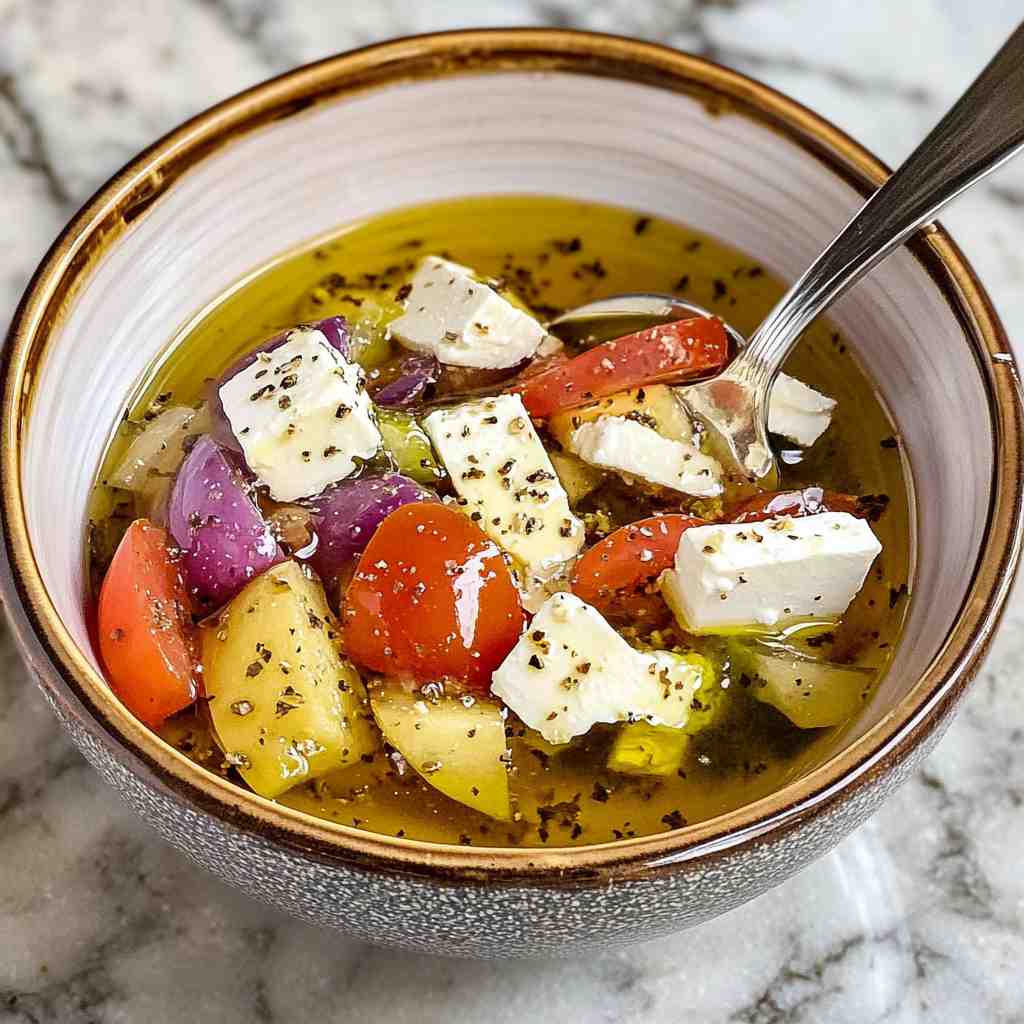Homemade Greek Salad Dressing

A classic salad is only as good as its dressing, and when it comes to Mediterranean flavor, nothing beats a Homemade Greek Salad Dressing. Bursting with bold herbs, zesty lemon, and the rich depth of extra virgin olive oil, this dressing is a staple in healthy and delicious cuisine. Not only does it elevate a bowl of greens, but it also serves as a fantastic marinade for grilled meats and roasted vegetables. Unlike store-bought versions, which often include preservatives and added sugars, this homemade recipe is clean, wholesome, and easy to make with pantry ingredients.
Whether you’re topping a crisp Greek salad with tomatoes, cucumbers, olives, and feta, or using it to drizzle over grilled chicken, this dressing adds a bright, tangy flavor that embodies the Mediterranean spirit. Let’s dive into the simple steps of creating your own Greek dressing at home a recipe you’ll want to make again and again.
❤️ Why You’ll Love This Recipe ?
- Quick and Easy: Ready in just 5 minutes with no special equipment.
- Customizable: Adjust herbs, lemon, or vinegar to your taste.
- Versatile: Use it on salads, sandwiches, or as a marinade.
- Healthy Ingredients: No added sugars, preservatives, or fillers.
- Authentic Taste: Captures the true Mediterranean essence with every spoonful.
- Meal Prep Friendly: Keeps well in the fridge for up to a week.
🧂 What You Need to Make Homemade Greek Salad Dressing ?
Here are the key ingredients you’ll need to make this classic dressing at home:
Ingredients:
- ½ cup extra virgin olive oil
The base of the dressing, choose a quality brand for the best flavor. - 3 tablespoons red wine vinegar
Gives the dressing its signature tang. - 1 tablespoon freshly squeezed lemon juice
Adds brightness and a fresh citrus note. - 1 teaspoon Dijon mustard
Helps emulsify the dressing and adds depth. - 2 cloves garlic, minced or grated
For a bold and punchy flavor. - 1 teaspoon dried oregano
A must-have herb in any Greek recipe. - ½ teaspoon dried basil (optional)
Adds another layer of herbal complexity. - ½ teaspoon sea salt
Enhances the overall flavor. - ¼ teaspoon freshly ground black pepper
Balances the acidity and gives a subtle kick. - Pinch of sugar or a drop of honey (optional)
Balances the acidity without making it sweet.
👨🍳 How to Make Easy Homemade Greek Salad Dressing Step-by-Step ?
Step 1: Prep Your Ingredients
Peel and mince the garlic finely or use a microplane grater for a smooth texture. Squeeze the lemon juice fresh and measure all ingredients.
Step 2: Combine the Ingredients
In a medium-sized mixing bowl or jar with a tight-fitting lid, add olive oil, red wine vinegar, lemon juice, Dijon mustard, minced garlic, oregano, basil (if using), salt, and pepper.
Step 3: Emulsify the Dressing
Whisk vigorously or shake the jar until the ingredients are well combined and the dressing looks slightly thickened. This emulsifies the oil and vinegar.
Step 4: Taste and Adjust
Taste the dressing and adjust salt, pepper, or lemon juice as needed. Add a pinch of sugar or honey if it tastes too tart.
Step 5: Store Properly
Transfer to a clean glass jar or bottle. Store in the refrigerator for up to one week. Shake well before each use.
🔄 Variations
Homemade Greek Salad Dressing is wonderfully flexible. Here are some delicious ways to switch it up:
- Creamy Greek Dressing: Add 1–2 tablespoons of plain Greek yogurt for a tangy, creamy twist.
- Spicy Version: Mix in a pinch of red pepper flakes or a dash of cayenne for a little heat.
- Lemon Herb Dressing: Double the lemon juice and add fresh chopped parsley or dill.
- Feta Dressing: Blend in ¼ cup of crumbled feta cheese for added richness and saltiness.
- Balsamic Greek Dressing: Substitute balsamic vinegar for red wine vinegar for a sweeter and deeper flavor profile.
- Low-Oil Version: Reduce olive oil to ⅓ cup and increase vinegar slightly to maintain balance.
- Vegan Sweetener: Use maple syrup instead of honey for a plant-based touch of sweetness.
These variations allow you to tailor the dressing for different uses from salads and grain bowls to marinades and dipping sauces.
📝 Cooking Note
One of the beautiful things about salad dressings is that they don’t require cooking, but there are still a few important technical details. The key to a great dressing lies in proper emulsification — the mixing of oil and vinegar into a smooth, cohesive mixture. Mustard plays a crucial role here. Without it, your oil and vinegar may separate quickly.
Always use fresh garlic and lemon juice for the best flavor. Bottled lemon juice and pre-minced garlic can dull the bright, zesty profile this dressing is known for. Another pro tip: if you find the raw garlic flavor too sharp, let the dressing sit for 15–20 minutes before using it. This mellows the flavor.
Lastly, the quality of your olive oil matters. Use cold-pressed, extra virgin olive oil for richness and authenticity. Lower-quality oils can overpower the dressing or turn it bitter.
🍽️ Serving Suggestions
This homemade Greek dressing is as versatile as it is flavorful. Naturally, it’s perfect for a classic Greek salad loaded with cucumbers, red onions, tomatoes, kalamata olives, and feta cheese. But don’t stop there:
- Marinate chicken or shrimp in the dressing for 30 minutes before grilling.
- Drizzle over roasted vegetables like zucchini, eggplant, or peppers.
- Add a splash to grain bowls with quinoa, arugula, and chickpeas.
- Toss with pasta salads to infuse a tangy herbaceous flavor.
- Use as a dip for warm pita bread or a finishing drizzle on gyros or shawarma.
This dressing also pairs well with lemon-roasted potatoes, or as a zesty touch in sandwich wraps.
🔧 Helpful Tips
- Shake It Up: Use a jar with a lid to shake your dressing. It’s quicker and emulsifies better than whisking.
- Balance the Acid: If it’s too tangy, mellow it out with a teaspoon of honey or maple syrup.
- Mince Garlic Finely: A microplane zester creates a smoother texture and prevents large garlic chunks.
- Let It Rest: Allow the dressing to sit for 10-15 minutes after making it to let the flavors meld.
- Use Room Temperature Ingredients: This helps the oil and vinegar blend better.
- Store Properly: Keep in a glass jar with a lid and refrigerate for freshness. It lasts up to 7 days.
- Shake Before Use: Oil separates naturally, so always shake before pouring.
- Double Batch: Make a larger batch to have ready for the week it’s great for meal prep!
- Try Fresh Herbs: For an elevated version, mix in chopped fresh oregano or basil.
- Avoid Low-Quality Oil: Always use good-quality olive oil to avoid bitterness and get authentic flavor.
🌟 Tips for the Best Homemade Greek Salad Dressing
Want restaurant-quality Greek salad dressing at home? Here’s how to achieve the best flavor and consistency every time:
- Use High-Quality Ingredients: Every ingredient matters when making dressings from scratch especially the olive oil and vinegar.
- Emulsify Properly: A whisk, immersion blender, or shaking in a jar can help keep the dressing from separating.
- Balance Flavor Profiles: A bit of mustard and a touch of sweetness bring harmony between the tangy and savory notes.
- Don’t Skip the Garlic: It’s essential for that bold, unmistakable Mediterranean flavor but keep it finely minced.
- Adjust to Taste: Greek dressing is very forgiving. Tweak salt, herbs, and acidity levels to match your preferences.
⏱️ Timing Overview
- Prep Time: 5 minutes
- Cooking Time: 0 minutes
- Total Time: 5 minutes
🧾 Nutritional Information (Per Serving – 2 tablespoons)
- Calories: 130
- Protein: 0g
- Sodium: 160mg
- Fat: 14g
- Saturated Fat: 2g
- Carbohydrates: 1g
- Sugar: 0.5g
- Fiber: 0g
❓ FAQs
Q1: How long does homemade Greek salad dressing last?
A: It lasts for up to one week in the refrigerator in a sealed jar.
Q2: Can I use fresh herbs instead of dried?
A: Yes! Use 2–3 times the amount of fresh herbs for the same flavor impact.
Q3: Is Greek salad dressing healthy?
A: Yes, when made at home it’s full of healthy fats, no additives, and no added sugar unless you choose to include a touch of honey.
Q4: Can I freeze Greek salad dressing?
A: Not recommended. The oil will solidify and the texture will be compromised.
Q5: What can I substitute for red wine vinegar?
A: Try white wine vinegar or apple cider vinegar as alternatives.
🏁 Conclusion
This Homemade Greek Salad Dressing is a game-changer in the kitchen. With its bold Mediterranean flavors, health-conscious ingredients, and endless versatility, it’s a must-have for any home cook. Whether you’re drizzling it on crisp veggies or using it as a marinade for grilled chicken, this dressing delivers every time. Once you try it, you’ll never want to go back to the bottled stuff.
So grab those pantry staples, mix up a jar, and bring the sunny flavors of Greece to your table today! 🇬🇷✨






